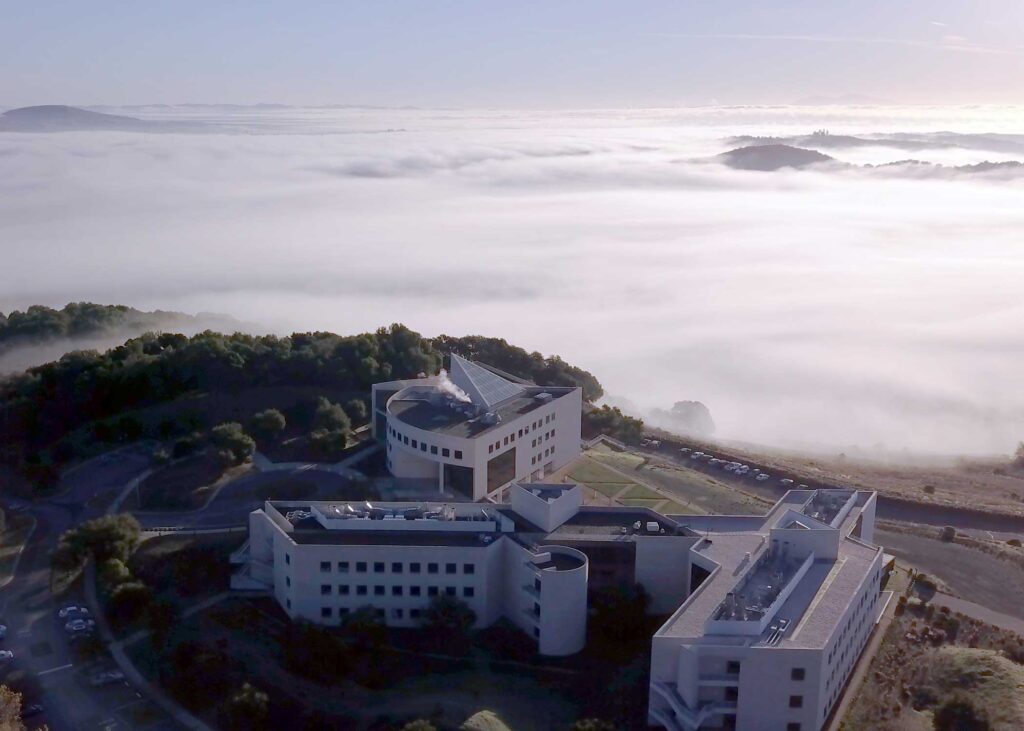Wellness
A Look at the Life-Changing Science Happening at Marin’s Buck Institute
 Courtesy of the Buck Institute
Courtesy of the Buck InstituteIn decades past, aging was left to the old, but with new discoveries surrounding ketones and senescent cells (more on that later), among myriad other innovations, the way we look at longevity is evolving like never before. In fact, aging well is something people as young as in their 20s are now taking into account.
“There’s a lot of misinformation — this idea that research on aging science is focused on making rich people live longer or that we’ll be able to live to 1,000. There is nothing that tells us that we’re going to get that kind of life extension. However, living healthily to 100, I’m convinced this is something that most of us can do today,” says Eric Verdin, M.D., CEO and president of the Buck Institute for Research on Aging, an independent biomedical research institute that studies aging and age-related disease in Novato. According to Verdin, 90 percent of your healthspan (the portion of your life span spent in good health) is determined by environmental factors like food choices, exercise and sleep, while only 10 percent is predetermined by your genetics. “That really puts the whole issue of healthspan squarely in your own lap,” says Verdin. And the earlier you start caring about that, the better.
There is a lot of conflicting information when it comes to eating well, getting enough exercise and enjoying quality sleep, making it difficult to understand which road to better health is the correct one (it’s actually different for everyone). But the Buck’s goal is to shed some light on that as well. “In addition to our research, this whole idea of (the Buck) becoming a source of validated information for the public, for me, is equally important,” adds Verdin.
There is another piece of the aging science puzzle that’s been making headlines in recent months — and that is the connection between meaningful social interactions and longevity. Verdin elaborates: “If you adopt a lifestyle that is incompatible with friendship, you’re probably hurting yourself. Friendship and our sense of purpose are two of the major determinants of healthspan and life span, which is why this pandemic is so toxic for the elderly; they’re isolated from their families and friends.” Understanding the different factors that affect aging and their connection to each other is vital to increasing the number of healthy years we spend at the end of our lives.
And in Marin, with our outdoor lifestyles, ease in securing healthy food and strong sense of community, increasing those years is a relatively easy thing to do. While the national average life span is 78 years old, the average life expectancy in Marin County is 87. “I would predict that if we were to take everyone and optimize them, we could probably bring average life expectancy from 87 to 95 — so we’re not so far from 100,” Verdin adds, “and that is amazing.”
In the pages that follow, we explore some of the groundbreaking work the scientists who are leading the way in aging science are doing.

Francesca Duncan, Ph.D.
The Center for Reproductive Longevity and Equality investigates the correlation between reproductivity and aging in women.
What does the term “equality” in the name of the center refer to?
Women are aging much earlier than men in terms of their reproductive capacity, which includes the hormones produced by the ovary. Those hormones are critical for the functioning of downstream organ systems. This fact runs up against the reality that many women need to put off having children to make room for their careers — and that the delay causes women to suffer the consequences of infertility that often happens with advanced reproductive age. Men don’t have that disadvantage; they can reproduce throughout their life span.
If scientists were able to delay menopause, what health benefits could this potentially provide for women as they age?
There is a lot of data that shows that menopause accelerates aging phenotypes. This is largely related to the fact that you have reduced estrogen, which is so important to the functioning of other organ systems. Any tissue or system that has estrogen or progesterone responsiveness — cardiovascular system, brain, immune cell function and bone health — would be positively influenced if we were able to delay the onset of menopause.
Are there lifestyle changes a woman can make to slow down the rate that her fertility declines?
We know that conditions like obesity and diabetes can have a negative impact on gamete health and fertility, so diet is really important. Smoking and environmental pollution can have negative impacts on reproductive health as well.
What are the negative implications of women being able to bear children into their 50s and beyond?
I don’t think it’s our goal to help women get pregnant in their 60s or 70s. There are issues with getting pregnant, and the burden of carrying a pregnancy at that age has its own challenges. Right now, we’re seeing women in their 30s and 40s having trouble with fertility and using assistive reproductive technologies to get pregnant. I would love to help those women conceive naturally. Additionally, we may be able to optimize endocrine function during aging, without impacting fertility. That could provide significant health benefits to women throughout their life span, including the years after childbearing.
Julie Andersen, Ph.D.
Studying the quest for new ways to prevent and cure neurodegeneration, with a particular focus on Alzheimer’s and Parkinson’s diseases.
What are some of the discoveries that have been unearthed with the funds from the NIA $3.4 million grant?
We received funds from the National Institute on Aging (NIA) to test the efficacy of a natural dietary gut flora–derived metabolite called urolithin A (UA) in slowing or preventing the presentation of Alzheimer’s disease. UA is metabolized in the gut from a precursor called ellagic acid (EA), which is found in several health foods including pomegranates, berries and walnuts, to name just a few.
As they age, the mice we are studying display plaques and tangles as well as losses in cognitive function similar to those observed in human Alzheimer’s patients. Studies have already shown that our microbiome — the bacteria, fungi, protozoa and viruses that live inside our gut — may play a role in neurological conditions such as autism, epilepsy and depression. We hypothesized that oral administration of UA would slow the onset of Alzheimer’s. It’s still early days, but the data we’ve collected so far suggests that UA is neuroprotective.
One of the things we’re really interested in testing is whether we can restore production of UA by introducing a more youthful microbiome to the older mice as they begin presenting with Alzheimer’s. Results from these studies would further our understanding of how reinstating a more youthful microbiome restores gut-brain signaling and protects brain neurons.
Have you discovered anything completely unexpected?
We had expected that UA would elicit neuroprotection, but what’s really exciting about our initial results is that it looks like we’ve been able to identify a dosage that works. This is extremely helpful in terms of UA’s potential use in treating diseases like Parkinson’s and Alzheimer’s. In a separately funded study, we looked at the efficacy of megadose vitamin D. Here, we saw something very surprising — the mice on a high-dose vitamin D displayed signs of diabetes as they aged. This only seemed to occur in the Alzheimer’s mice and not in their normal siblings. We found that this was accompanied by distinct changes in the gut microbiota that appear to selectively drive the mice into a diabetes-like state.
Vitamin D deficiency has been linked to Alzheimer’s, leading to a rising concern that older individuals may be self-medicating to avoid risk of diabetes, resulting in consumption of large dosages, of which the potential negative consequences are currently unknown. We think that this could have important implications given that diabetes is a major risk factor for Alzheimer’s.
How much of a factor is lifestyle — even for younger people — when you talk about developing diseases like Alzheimer’s and Parkinson’s?
It’s huge. A NIA-funded study published this past June in the journal Neurology showed that people who engaged in regular physical activity, did not smoke, consumed light-to-moderate amounts of alcohol, ate a high-quality diet, and engaged in cognitive activities had a 60 percent reduced risk for developing Alzheimer’s.
Parkinson’s has also been associated with environmental factors such as increased exposure to pesticides and a high-fat diet and is slowed by physical exercise and increased consumption of beverages like tea, coffee and antioxidant-containing foods. Physical exercise including aerobics, resistance training and stress management via mind-body practices including meditation, yoga, tai chi and dance have also been suggested to be beneficial.
Judith Campisi, Ph.D.
Understanding cellular senescence, the cause of chronic inflammation connected to many age-related diseases.
Can you explain what cellular senescence is?
When cells become senescent, they acquire three new features: they stop dividing; they become somewhat resistant to dying; and they secrete many bioactive molecules (the senescence-associated secretory phenotype or SASP). The SASP seems to be particularly important for driving aging because it includes a large number of factors that promote inflammation. Low-level chronic inflammation is a hallmark of aging tissues (and has been termed “inflammaging”). Inflammation, while an essential process during tissue repair, can be destructive to tissue structure and function when it is chronic.
Senescence is hard to study because there are no specific senescence markers. Also, each cell type differs from others with regard to the genes it expresses, especially genes encoding SASP factors, and those change over time. However, senescent cells and the SASP can and do, under certain circumstances, have beneficial effects. Examples include certain times during embryogenesis and during wound healing and tissue repair. Thus, it is important to know when and where and what type of senescent cells are present in order to understand their role in aging and disease.
What is the correlation between senescent cells and disease?
The correlation is excellent — in mice, humans and other mammals, even in zebra fish. But correlation does not prove causality. However, transgenic [genetically modified] mouse models now exist where it is possible to selectively eliminate senescent cells at any point in the life span. Experiments using these mice clearly demonstrate that senescent cells are indeed causal for a surprisingly large number of human age-related diseases, ranging from neurodegeneration to late-life cancer. Fewer studies have used senolytic drugs (which kill senescent cells), but those results support this conclusion. That is, eliminating senescent cells can either delay the onset, ameliorate the severity, or, in some cases, reverse the manifestation of many age-associated diseases.
Two important lessons we’ve learned from the above studies. First, senescent cells are almost always rare, comprising only a small percentage of cells in any tissue. Second, in transgenic mice it is not necessary to kill all senescent cells in order to delay, ameliorate or reverse age-related diseases. Generally, eliminating 70 to 80 percent of senescent cells is sufficient.
Are there any external factors that affect the aging of senescent cells in younger people?
A number of laboratories have shown that at least two interventions — each known to promote healthy aging — also reduce the abundance of senescent cells, or at least the abundance of cells that express detrimental (inflammatory) SASP factors: caloric restriction and exercise.
Brianna Stubbs, Ph.D.
The lead translational scientist in the Ketones Lab in Ketones Lab is using the body’s own metabolic signals to increase longevity.
Can you explain what a ketone is?
Ketones are a family of compounds that our body can break down for energy instead of its usual fuels, glucose (sugar) or fat. The main reason that ketones exist is to fuel our brain when we are running low on glucose stores. Our body only makes ketones when glucose stores are running low, such as if you follow a very low carbohydrate diet or if you don’t eat any food for more than a day or so. Until recently, the only way to raise the amount of ketones in the blood was to follow a low-carbohydrate diet or fast, but now scientists are developing drinkable ketones that can give the body access to ketones without any other dietary changes.
How do ketones play a factor in the way the body responds to stressors and how might they improve healthspan?
Situations that cause the body’s carbohydrate stores to run out are stressful, especially when we think about ketones in the context of starvation. It is important that the body turns on a coordinated set of processes that protect it from rapid breakdown and would help us to survive long periods of starvation. In that regard, the presence of ketones is part of the way the body signals the need for self-preservation. Ketones may help to switch on multiple pathways that cause cells to clean themselves up and regenerate; this could help with healthspan. It is early days, but research shows that ketones have promise to treat some of the common diseases of aging such as heart failure and neurodegeneration.
Your lab is working on a supplement to mimic the effects of the ketogenic diet — can you tell us more about that?
We have developed a new form of edible ketone, called a ketone ester. This is a compound that breaks down inside the body and raises the levels of ketones in the blood without the person having to follow a ketogenic diet or undertake fasting. It also works very quickly and doesn’t rely on fat breakdown like the ketogenic diet. We think that having ketones in the blood could be helpful for some aspects of health and longevity, and you might be able to get some of these benefits just by drinking ketone esters without needing to follow the ketogenic diet. The ketone ester will be the main ingredient of a new product, Metabolic Switch, that is being released this year by a company called Juvenescence.
Are there any connections between ketones, Covid-19 and immunity?
It’s important to say that we really don’t know for sure yet if and how ketones could interact with the disease process of Covid-19. From our knowledge of the basic science of ketones we suspect that they could interact with some aspects of the immune system (i.e., inflammation and oxidative stress), which might help with the response to infection. While we suspect that could have a positive effect, there are also ways in which these ketone effects could be counterproductive. We need to do more research to be sure, but it is an interesting possibility.
Ketones might also be helpful in mitigating some of the conditions that come alongside being in intensive care with a disease like Covid-19. ICU patients have a high rate of heart damage, delirium and also muscle wasting — there is mechanistic evidence to support the use of ketones to prevent these side effects. But again, intensive care is a complex set of stressors and we can’t be sure if the net effect would be positive or negative until we test this in a carefully controlled setting.
The Buck Institute is a nonprofit organization and relies on donations.
To get involved, visit www.buckinstitute.org.









